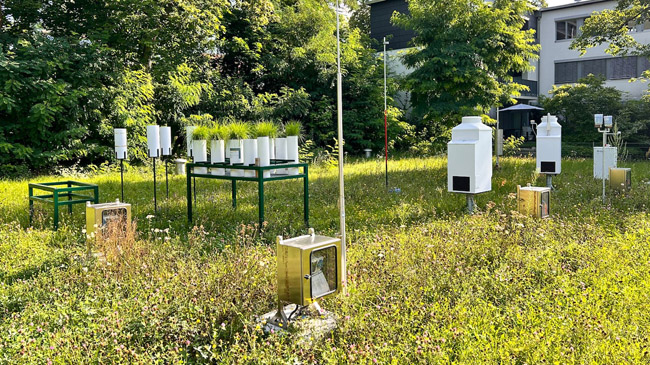The environmental monitoring of immission ecology at the LfU deals intensively with the inputs and effects of chemicals via air and precipitation on ecosystems, soils and plants. How chemicals behave in the environment, how they are transported and in what concentrations they are found are important information for answering the following questions:
- Is there evidence of harmful inputs from air and precipitation that affect the state of the ecosystem under consideration?
- How do the inputs develop over time?
- Is legislation to monitor inputs effective or sufficient?
- Can models of the environmental behavior of chemicals be confirmed with real measurements?
The OPTIMON project restructured the immission ecology monitoring network, reviewed the list of substances to be investigated, supported the long-term monitoring of inputs and contributed to the legislative regulation of pollutants. The project ran from April 2020 to September 2024.
Monitoring of POPs at 2650 m and in the lowlands
The Schneefernerhaus Environmental Research Station (UFS) on the Zugspitze is a special location for chemical monitoring. One focus at this alpine station is the measurement of so-called persistent organic pollutants, or POPs for short, in air and precipitation samples. With the OPTIMON project, the series of measurements on POPs at the Zugspitze were continued and transferred to a reliable long-term monitoring system. The monitoring at the Zugspitze was integrated into the immission ecology monitoring network. To record POPs in the vicinity of possible sources, a reference station for the Alpine site in Nuremberg was put into operation in 2024 and the measurements between the lowlands and the Zugspitze were coordinated as far as possible.
The measurements are used to monitor and assess pollutant inputs and act as an early warning system. The number of samples was reduced as far as possible, collection methods evaluated and quality measures ensured.
 A new measuring station was set up in Nuremberg in 2024. Air samples are also tested here for the content of persistent organic pollutants. The station serves as a reference site for the station at the Zugspitze.
A new measuring station was set up in Nuremberg in 2024. Air samples are also tested here for the content of persistent organic pollutants. The station serves as a reference site for the station at the Zugspitze.
New substances and long-distance transport
With the optimized immission-ecological monitoring, the LfU is able to quickly detect newly occurring substances. With the help of the two measuring stations Schneefernerhaus and Nuremberg, it is possible to check whether recorded chemicals originate from regional sources or are introduced via global long-distance transport, as they are only insufficiently degraded in the atmosphere. Persistence and thus the tendency for long-distance transport characterize a substance as problematic and necessitate regulation. The LfU data is used by federal and EU authorities to monitor and, if necessary, regulate chemicals.
The development of a PFAS monitoring network
The immission ecology monitoring network was used to clarify the extent to which perfluorinated and polyfluorinated alkyl compounds (PFAS) are released into the environment via precipitation. Currently, samples of precipitation are collected at several locations in Bavaria throughout the year for four weeks at a time and analyzed for a broad spectrum of PFAS.
The measurements of PFAS in the deposition show that usually only individual PFAS can be determined, especially short-chain PFAS.
Depending on the definition, trifluoroacetic acid (TFA) is also included in the PFAS group. TFA is detected in significantly higher concentrations and at almost all locations in the precipitation samples. The Bavarian measurements thus confirm the assumption that TFA is currently ubiquitous. No pronounced acute toxicity has yet been demonstrated for TFA. However, it is a highly persistent and mobile substance that has already been detected in groundwater and whose entry into the environment must be viewed critically. The measurements are being continued and evaluated by specialist personnel.
Funding
OPTIMON was financed by the Bavarian State Ministry for the Environment and Consumer Protection.
Project management
Bavarian State Office for the Environment, Department 76: Substance Testing Laboratory, Environmental Monitoring
Contact
- Margit Krapp, Tel: +49-(0)-881/93541-1138
- Dr. Jutta Köhler, Tel: +49-(0)-881/93541-1137
- Dr. Korbinian Freier, Tel: +49-(0)-881/93541-1118

